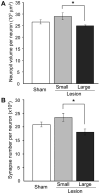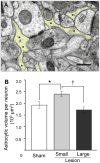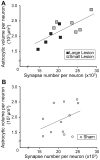Lesion size-dependent synaptic and astrocytic responses in cortex contralateral to infarcts in middle-aged rats
- PMID: 20336630
- PMCID: PMC2904857
- DOI: 10.1002/syn.20777
Lesion size-dependent synaptic and astrocytic responses in cortex contralateral to infarcts in middle-aged rats
Abstract
In young adult rats, unilateral lesions of the sensorimotor cortex lead to neuronal structural plasticity and synaptogenesis in the contralateral motor cortex, which is connected to the lesion site by transcallosal fibers. The contralesional neural plasticity varies with lesion size and results from the convergence of denervation-induced reactive plasticity and behavioral asymmetries. It was unknown whether similar effects occur in older animals. Furthermore, the coordination of synaptic responses with that of perisynaptic astrocytes had not been investigated. In this study, middle-aged rats (14-16 months old) were given sham-operations or unilateral ischemic lesions of the sensorimotor cortex. Fifty days later, numerical densities of neurons and synapses and morphological characteristics of astrocytic processes in layer V of the contralesional motor cortex were measured using stereological light and electron microscopy methods. Lesions resulted in behavioral asymmetries, but no significant synapse addition in the contralesional motor cortex. Synapse number per neuron was negatively correlated with lesion size and reduced opposite larger lesions compared with smaller ones. Astrocytic changes were also lesion size-dependent. Astrocytic hypertrophy was observed only after smaller lesions and was associated with greater coverage and greater numbers of synapses. These findings are consistent with those in younger rats indicating an inverse relationship between lesion size and adaptive neuronal restructuring in denervated cortex. However, they indicate that the synaptogenic reaction to this lesion is relatively limited in older animals. Finally, the results indicate that structural plasticity of perisynaptic astrocytes parallels, and could play a role in shaping, synaptic responses to postischemic denervation.
Figures





References
-
- Adams FS, Schwarting RKW, Huston JP. Behavioral and neurochemical asymmetries following unilateral trephination of the rat skull - is this control operation always appropriate? Physiol Behav. 1994;55:947–952. - PubMed
-
- Adkins DL, Bury SD, Jones TA. Laminar-dependent dendritic spine alterations in the motor cortex of adult rats following callosal transection and forced forelimb use. Neurobiol Learn Mem. 2002;78:35–52. - PubMed
-
- Adkins DL, Campos P, Quach D, Mark BC, Schallert K, Jones TA. Epidural cortical stimulation enhances motor function after sensorimotor cortical infarcts in rats. Exp Neurol. 2006;200:356–370. - PubMed
-
- Adkins DL, Voorhies AC, Jones TA. Behavioral and neuroplastic effects of focal endothelin-1 induced sensorimotor cortex lesions. Neuroscience. 2004;128:473–486. - PubMed
Publication types
MeSH terms
Substances
Grants and funding
LinkOut - more resources
Full Text Sources
